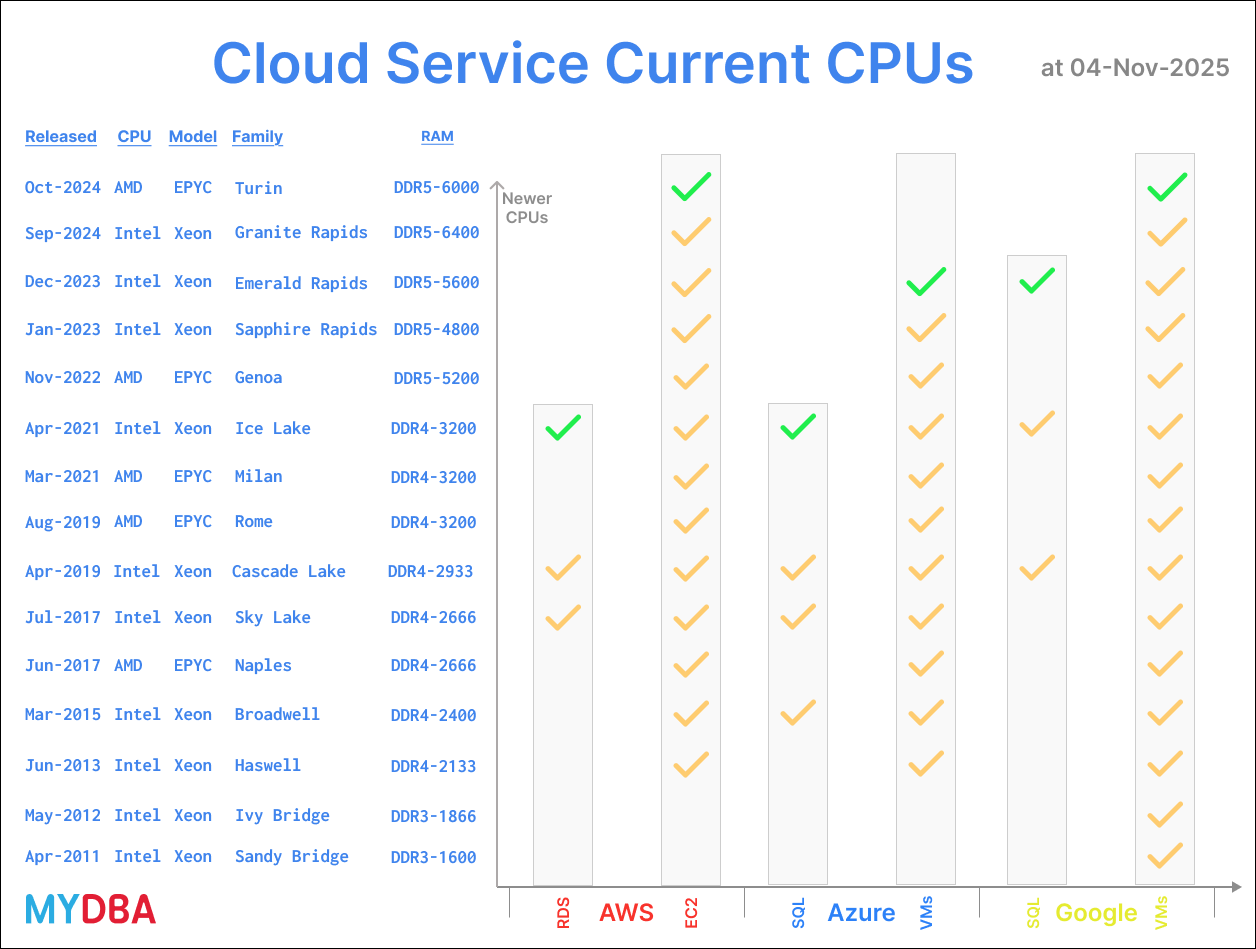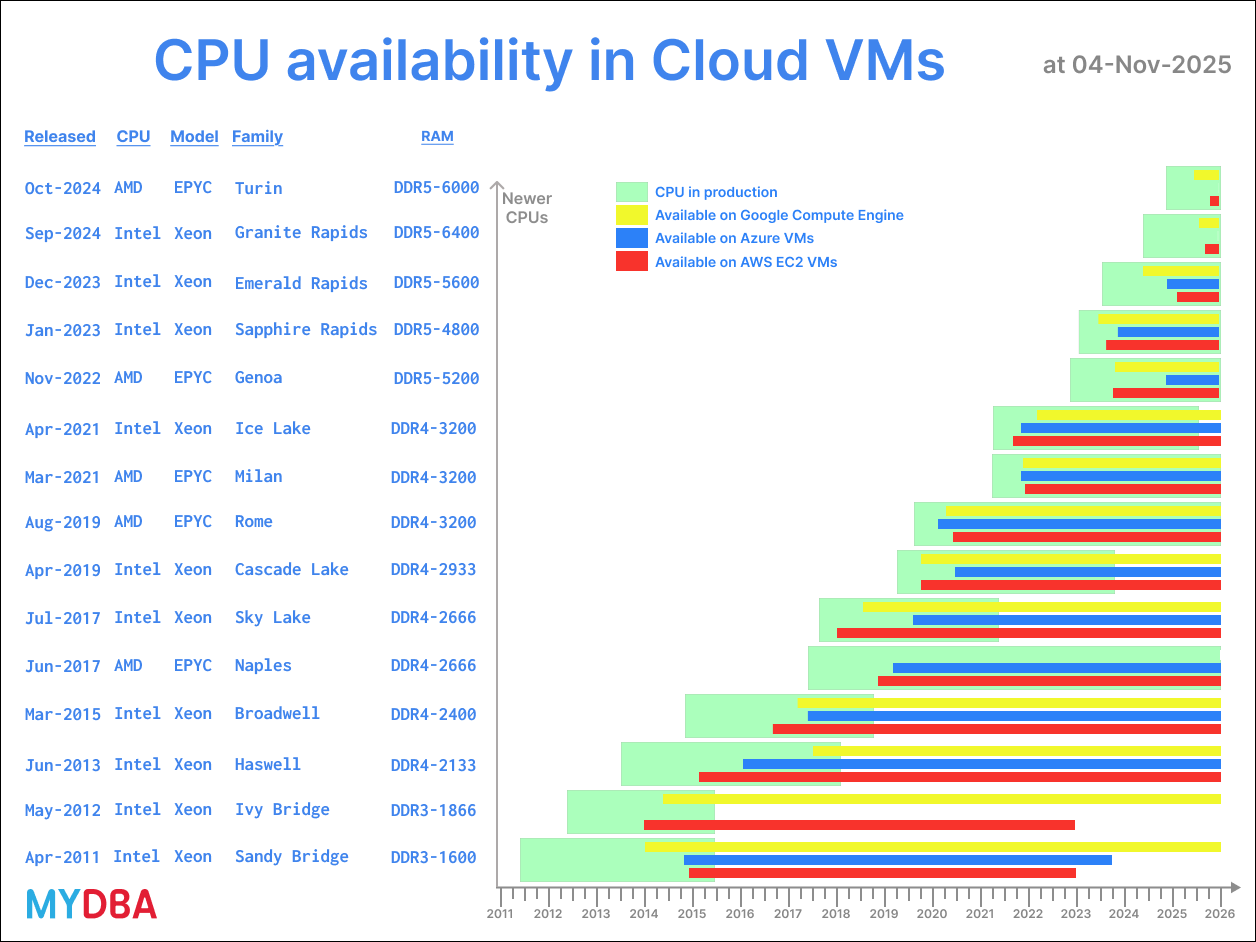Clouds services running on old, slow CPUs

Spin up an Azure SQL Server Managed Instance on General Purpose tier today and you could be running on ten year old Intel Xeon Broadwell
CPUs.
Upgrade to Premium tier and top dollar gets you Intel's 5 year old Ice Lake
Xeon CPU design, which went out of production at Intel earlier this year.
Over at AWS RDS, you get to choose your CPU but from a very short list, where your most current option is Intel's Ice Lake
Xeon CPU, no better than Microsoft's offering.
Google's Cloud SQL offers the most modern CPUs, including Intels 5th Gen Xeon Emerald Rapids
, arguably making Google's
Cloud SQL the highest performing & most efficient SQL Server database service of the top three major clouds.
Here's a list of what's currently available in the three major cloud database and VM services:

All three clouds do offer newer, faster CPUs in their VM / IaaS services, just not in their highly priced cloud SQL Server database services, as shown in Figure 1 above.
The newest VM CPUs are roughly twice as powerful as the newest database service CPUs, meaning you need roughly twice as many CPUs in database services than in VM equivalents. Memory speeds are also roughly twice as fast in the newest VM CPUs vs database service CPUs, adding to the picture.
Licensed database engines such as Microsoft SQL Server are charged on a per CPU core basis, so more CPUs means more database service or software licensing costs.
Older, slower CPUs require more CPUs to handle any given database workload than newer CPUs, so older CPUs require more database service fees or license costs.
More CPUs also means more infrastructure costs, so open source / free database engines such as Postgresql are not immune from the cost impact from using older CPUs.
Already costly cloud database costs become even more expensive when old, slow CPUs multiply service fees, which are also tied to the number of CPUs used.
Cloud vendor profits soar when customers pay to use compute assets purchased up to ten years ago, long after the depreciated useful life of those assets. At this point, cloud vendors receive income without associated depreciation expenses, pure profit.
Whilst this might seem great for shareholders, it mis-aligns income from expenses in financial reporting, shifting depreciation expenses forward to earlier in the actual useful life of assets, lowering profits in earlier years.
Microsoft CFO Amy Hood announced that depreciation of Azure cloud compute assets would be extended from four years to six years in the 2022 Q4 investor earnings call:
"First, effective at the start of FY23 we are extending the depreciable useful life for server and network equipment assets in our cloud infrastructure from four to six years.."
This policy change improves financial reporting and is within GAAP guidance but all clouds, including Microsoft, are extending the use of compute assets beyond 6 years, as shown below:

In Figure 2 we show each of the main Intel & AMD CPUs provisioned in VMs and SQL Server database services in the three major clouds, including production periods (green boxes) and first appearance in each major service.
All major clouds continue delivering VM services on Intel's twelve year old Haswell CPUs.
Microsoft continues delivering cloud SQL Server services based on Intel's ten year old Broadwell CPUs.
Azure has also historically been slow to deploy Intel's latest CPUs, and also more restrictive in CPU selection options with its SQL Server PaaS services as described above.
Currently, AWS EC2 and Google Cloud both currently offer Intel's latest 6th Gen Xeon Granite Rapids
and AMD EPYC Turin
CPUs,
whilst Azure offers Intel 5th Gen Xeon Emerald Rapids
in their VM types.
To manage cost, it is important to select compute options carefully when planning cloud database services, particularly with licensed database engines such as SQL Server.
Select services that provide more modern CPUs, as this allows you to reduce the number of CPU cores provisioned and, importantly, the associated database software or cloud database service licensing costs.
Carefully weigh the costs / benefits of database services vs IaaS / VM based alternatives where newer, faster CPUs are available which can reduce your overall costs significantly.
Contact Us if you'd like some help!
